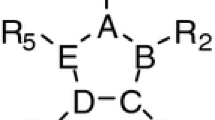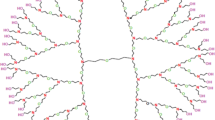Abstract
The relationship of adductability of branched chain aliphatic compounds in urea with topological descriptors has been investigated. Wiener’s index – a distance-based topological descriptor, molecular connectivity index, an adjacency-based topological descriptor and eccentric connectivity index – an adjacency-cum-distance based topological descriptor were employed for the present study. A data set comprising of 133 branched aliphatic compounds was segregated into training and test sets. The values of all the three topological indices for all the compounds constituting the training and test sets were computed using an in-house computer program. Resulting data of the training set was analyzed and suitable models were developed after identification of the adductible ranges. Subsequently, each compound in the training set was either classified as adductible or non-adductible using these models, which was then compared with the reported adductability in urea. An accuracy of prediction of ≥86% was observed using these models in the training set. These models were then cross-validated using the test set. An accuracy of prediction of ≥80% was observed during cross-validation of these models in an independent test set.
Similar content being viewed by others
References
K. Takemoto and N. Sonoda: In J.W. Atwood, J.E.D. Davis, and D.D. MacNicol (eds.), Inclusion Compounds, Academic Press, London (1984), pp. 47–67
Harris K.D.M., (2003) Phase Trans. 76: 205
Bishop R., Dance I.G., (1989) Topics Curr. Chem. 149: 139
Redlich O., Gable C.M., Dunlop A.K., Millar R.W., (1950) J. Am. Chem. Soc 72: 4155
Smith A.E., (1952) Acta Crystalogr. 5: 224
Zimmerschied W.J., Dinnerstein R.A., Weitkamp A.W., Marschner R.F., (1950) Ind. Eng. Chem 42: 1300
Harris K.D.M., Thomas J.M., (1990) J. Chem. Soc. Faraday Trans. 86: 2985
Harris K.D.M., Gameson I., Thomas J.M., (1990) J. Chem. Soc. Faraday Trans. 86: 3153
Schlenk W., (1949) Justus Liebigs Ann. Chem. 565: 204
Swern D., (1955) Ind. Eng. Chem. 47: 216
Chao M.H., Harris K.D.M., Kariuki B.M., Bauer C.L., Foxman B.M., (2002) Angew. Chem. Int. Ed. 106: 4032
Lefort R., Toudic B., Etrillard J., Bourges P., Currar R., Breczewski T., (2001) Eur. Phys. J. B24: 51
Waber Th., Boysen H., Frey F., (2000) Acta Cryst. B56: 132
Hollingsworth M.D., Werner-Zwanziger U., Brown M.E., Chaney J.D., Huffamn J.C., Harris K.D.M., Sharon P.S., (1999) J. Am. Chem. Soc. 121: 9732
Mayo S.C., Welberry T.R., Brown M., Tarr A., (1998) J. Solid State Chem. 141: 437
Frost R., Boysen H., Frey F., Jagodzinski H., (1986) J. Phys. Chem. Solids 47: 1089
Shannon I.J., Harris K.D.M., Rennie A.J.O., Webster M.B., (1993) J. Chem. Soc., Faraday Trans. 89: 2023
Yeo L., Harris K.D.M., (1998) J. Chem. Soc. Faraday Trans. 94: 1633
Masunov A., Dannenberg J.J., (2000) J. Phys. Chem. 104: 806
Schiessler R.W., Flitter D., (1950) J. Am. Chem. Soc. 74: 1720
R.A. Findlay: In H.M. Schoen and J.J. Mcketta (eds.), New Chemical Engineering Separation Techniques, Interscience Publishers, New York (1962), pp. 257–318
Katritzky A.R., Gordeeva E.V., (1993) J. Chem. Inf. Comput. Sci. 33: 835
Randic M., (1990) J. Chem. Inf. Comput. Sci. 31: 311
Trinajstic N., (1983) Chemical graph theory CRC Press Boca Raton, FL
Basak S.C., Balaban A.T., Grunwald G.D., Gute B.D., (2000) J. Chem. Inf. Comput. Sci. 40: 891
Wiener H., (1947) J. Am. Chem. Soc. 69: 17
Balaban A.T., (1982) Chem. Phys. Lett. 89: 399
Hosoya H., (1972) J. Chem. Doc. 12: 181
Randic M., (1975) J. Am. Chem. Soc. 97: 6609
Gutman I., Randic M., (1977) Chem. Phys. Lett. 47: 15
Sharma V., Goswami R., Madan A.K., (1997) J. Chem. Inf. Comput. Sci. 37: 273
Rose K., Hall L.H., Kier L.B., (2002) J. Chem. Inf. Comput. Sci. 42: 651
Kier L.B., Hall L.H., Murray W.J., Randic M., (1975) J. Pharm. Sci. 64: 1971
Gupta S., Singh M., Madan A.K., (2001) J. Comput. Aid Mol. Desig. 15(7): 671–8
Kier L.B., Hall L.H., (1986) Molecular Connectivity in Structure–Activity Analysis Wiley New York
Karelson M., (2000) Molecular Descriptors in QSAR/QSPR Wiley-Interscience New York
Diudea M.V., (2001) QSPR/QSAR Studies by Molecular Descriptors Nova, Huntington New York
Linstead R.P., Whallwy M., (1950) J. Chem. Soc. 2987
Truter E.V., (1951) J. Chem. Soc 2416
Radell J., Connolly J.W., Cosgrove W.R., (1961) J. Org. Chem. 26: 2960
Brodman B., Radell J., (1967) Separat. Sci. 2: 139
Author information
Authors and Affiliations
Corresponding author
Rights and permissions
About this article
Cite this article
Thakral, S., Madan, A.K. Topological Models for Prediction of Adductability of Branched Aliphatic Compounds in Urea. J Incl Phenom Macrocycl Chem 56, 405–412 (2006). https://doi.org/10.1007/s10847-006-9123-0
Received:
Accepted:
Published:
Issue Date:
DOI: https://doi.org/10.1007/s10847-006-9123-0




